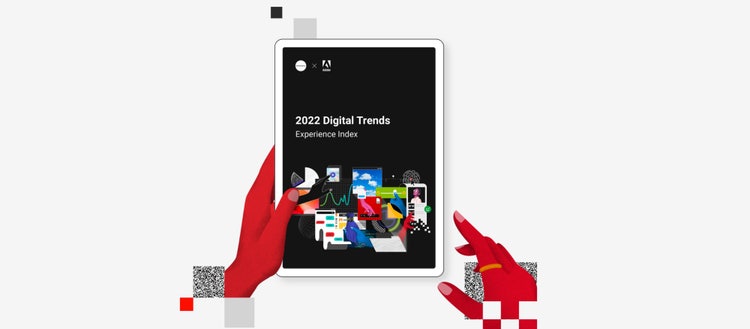2022 Digital Trends Report reveals companies must fast-track digital change — or be disrupted

The dramatic shifts in customer behavior brought on by COVID-19 will not only continue in 2022, they will accelerate, according to the 12th annual Digital Trends Report from Adobe and eConsultancy, which also reveals how organizations will stay competitive in our ever-shifting environment.
Personalization at scale: how companies connect with current and future customers through individualized and tailored experiences.
“This year’s findings make one thing clear,” says David Carrel, VP, Marketing, Adobe Experience Cloud “The events of 2020 and 2021 were out of the ordinary but the resulting shift in customer behavior is here to stay.”
The Digital Trends report findings, based on surveys from nearly 10,000 marketers, consultants and practitioners, focuses on the following areas where marketing and IT leaders will focus their energy, to stay competitive in 2022.
Accelerating digital for customers
While some businesses powered through 2020 and 2021 with short term hacks and digital tactics, the gap between the leading companies and the laggards has widened. 87 percent of senior executives believe customer expectations have been digitally rewired, and that success is defined by a brand’s ability to respond. This can be seen in how brands now do business: 75 percent of companies reporting a surge in the use of digital channels by existing customers, for example.
More than 50 percent of senior executives have responded by upping their investment in platforms that empower teams across their business to serve customers in today’s complex omnichannel environment. Indeed, customer data technologies and experience platform technologies rank among their top spending priorities for 2022.
Earning customer trust
Brands hold a fragile social contract with their customers. Every data point they collect comes with the expectation that they will deliver valuable experiences while protecting that data to the highest standard. To paraphrase Belinda Finch, CIO at Three, people today want simplicity, transparency, and trust.
Leading businesses understand that with their current systems, they cannot manually manage data responsibly at the scale necessary. That is why they are investing in platforms that allow them to unify and activate their data, while applying powerful governance across every audience, channel, and region.
Meanwhile, with third-party cookies becoming less and less relevant, Marketing and IT leaders are shifting focus to first data, a critical asset for businesses that hope to thrive in a cookieless future.
First party data: the information about customers that a company collects directly from them, and owns. Such as phone, email and purchase history and communication preferences.
Unlocking new levels of agility
The research also reveals leading companies have baked agility into their day-to-day practices. They are becoming more agile through improved data access, better workflow management, and comprehensive employee training.
92 percent of senior executives saying their agility level will determine their success as a marketing organization. 65 percent of marketing leaders rate their speed of getting and then acting on customer insights, as strong or very strong. By contrast, just 5 percent of laggards say they can collect these insights at speed.
Leaders also know that to improve their customer experience they must reduce friction in how employees connect with each other and do work. Respondents ranked poor integration between technology systems, workflow issues, and a lack of digital skills as their top internal barriers to delivering excellent customer experiences. In response, 59 percent of digital leaders are investing in talent and training to make their teams more productive.
Upping collaboration between IT and marketing leaders
The early days of COVID-19 cemented the relationship between marketing and IT leaders, whose teams needed to align overnight and transform customer experiences for the realities of a digital world. As customer behaviors continue to change at breakneck speed, CMOs and CIOs must collaborate even more closely to combine customer experience and digital strategies with new levels of creativity and innovation.
Encouragingly, 83 percent of senior executives agree that marketing and IT have a shared vision. According to report participant Walgreens SVP and CMO, Patrick McLean, "CMOs and CIOs really need to be working hand in glove. It is not just alignment to roadmaps and technology needs, but in how customers respond and their expectations and how we’re adapting to their needs in real-time.”
Customizing the experience for one while still reaching millions
Finally, there is an agreement among digital leaders that personalization at scale is their primary imperative for 2022, and that they need a combination of integrated data, insight-focused analytics, and marketing automation to deliver. Nearly 60 percent of senior executives rank data and insights as their top technological priority for the year ahead.
They are also committed to making these systems work together and eliminating siloes in their marketing stack. 37 percent of marketing and IT practitioners admit the biggest barrier holding back great customer experiences is poor integration between their technology systems. Meanwhile, an additional report completed by Adobe found that integrated marketing platforms can reduce a business’s total cost of ownership by up to 35 percent and increase speed to market by 30 percent.
“We have the capabilities today to do so much with real-time personalization through content, analytics, automation — and increasingly AI — which will open up new opportunities for brands to differentiate themselves and connect with customers,” says Carrel. “This is the holy grail of marketing in 2022: true personalization at scale that offers tailored experiences and content for customers across every channel at the moments that matter to them.”